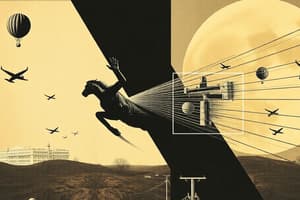Podcast
Questions and Answers
What is the first law of motion according to Newton?
What is the first law of motion according to Newton?
A body continues to be at rest or in motion unless an external force is applied to it.
What does Newton's second law of motion state?
What does Newton's second law of motion state?
The greater the mass of a body, the greater the force needed to accelerate it.
What is the third law of motion according to Newton?
What is the third law of motion according to Newton?
For every action, there is an equal and opposite reaction.
How might Newton's laws of motion apply to flight?
How might Newton's laws of motion apply to flight?
When a rocket's engine ignites, what equal and opposite forces are in action?
When a rocket's engine ignites, what equal and opposite forces are in action?
Flashcards are hidden until you start studying
Study Notes
Newton's Laws of Motion
- Sir Isaac Newton developed three laws of motion to explain movement.
- Newton's laws of motion describe how forces affect objects.
- These laws are fundamental to understanding how things move in the universe.
First Law of Motion - Inertia
- Inertia is the tendency of an object to resist changes in its motion.
- An object at rest will stay at rest, and an object in motion will stay in motion at a constant speed and direction unless acted upon by a force.
Second Law of Motion
- The force needed to accelerate an object is directly proportional to its mass.
- Acceleration is the rate of change of velocity.
- The greater the mass of an object, the more force is needed to make it move.
Third Law of Motion
- For every action, there is an equal and opposite reaction.
- When one object exerts a force on another object, the second object exerts an equal and opposite force on the first object.
Application of Newton's Laws to Flight
- Newton's Third Law of Motion explains how airplanes fly.
- The wings of an airplane are designed to create an upward force called lift.
- This lift is generated by the difference in air pressure above and below the wings, which is created by the shape of the wings and the way they move through the air.
- When the airplane's engines create thrust, which is the force that propels the airplane forward, this force is equal and opposite to the force of the air pushing back against the wings.
Rocket Engine and Equal and Opposite Forces
- When a rocket's engine ignites, it expels hot gases out of the back of the rocket.
- The escaping gases create a force called thrust, which propels the rocket upward.
- The force of the thrust is equal and opposite to the force of the gases pushing back on the rocket.
- This is an example of Newton's Third Law of Motion.
Studying That Suits You
Use AI to generate personalized quizzes and flashcards to suit your learning preferences.




